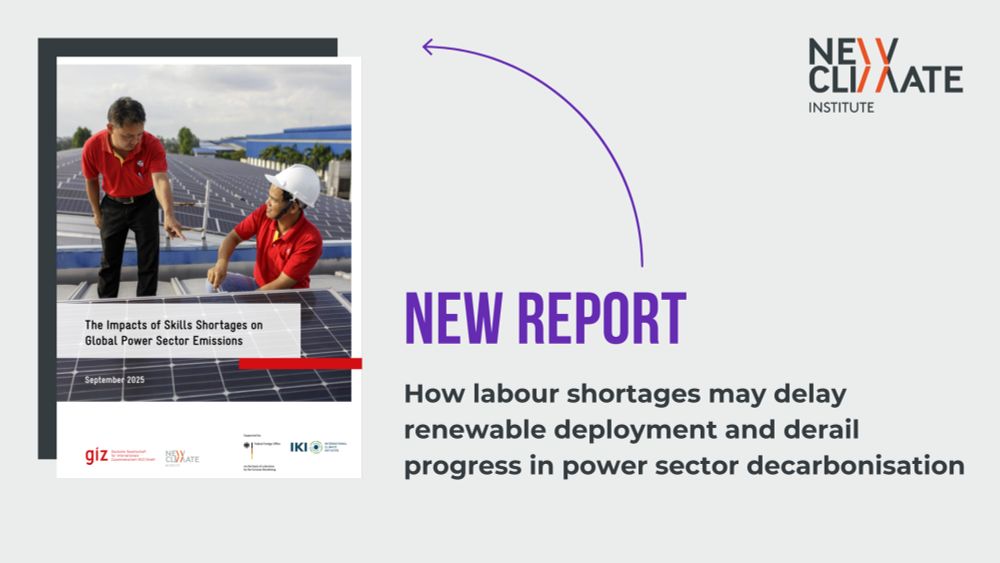
NewClimate Institute
@newclimate.bsky.social
NewClimate Institute for climate policy and global sustainability brings action on climate change from ideas to implementation. 🔗(https://newclimate.org/)
↘ GHG emissions may peak before 2030 but remain off track for Paris goals.
📉 Projections remain on a downward trend, despite slower progress in the US.
⚡ Progress toward 2030 and 2035 NDC targets is not happening fast enough.
🌡️ Every fraction of a degree matters. The ambition gap must close.
📉 Projections remain on a downward trend, despite slower progress in the US.
⚡ Progress toward 2030 and 2035 NDC targets is not happening fast enough.
🌡️ Every fraction of a degree matters. The ambition gap must close.
November 7, 2025 at 8:44 AM
↘ GHG emissions may peak before 2030 but remain off track for Paris goals.
📉 Projections remain on a downward trend, despite slower progress in the US.
⚡ Progress toward 2030 and 2035 NDC targets is not happening fast enough.
🌡️ Every fraction of a degree matters. The ambition gap must close.
📉 Projections remain on a downward trend, despite slower progress in the US.
⚡ Progress toward 2030 and 2035 NDC targets is not happening fast enough.
🌡️ Every fraction of a degree matters. The ambition gap must close.
Plastics are part of an interconnected global system and addressing their impacts requires international coordination.
Explore how regional actions can support a net-zero emissions future for the plastics sector:
🔗 bit.ly/43GAdn3
Explore how regional actions can support a net-zero emissions future for the plastics sector:
🔗 bit.ly/43GAdn3

Regional priorities for tackling plastic lifecycle impacts
This report provides a comprehensive analysis of the plastics sector’s climate impact, mapping emissions across the value chain. It proposes the decarbonisation of the sector through sequencing a set ...
bit.ly
November 6, 2025 at 1:13 PM
Plastics are part of an interconnected global system and addressing their impacts requires international coordination.
Explore how regional actions can support a net-zero emissions future for the plastics sector:
🔗 bit.ly/43GAdn3
Explore how regional actions can support a net-zero emissions future for the plastics sector:
🔗 bit.ly/43GAdn3
Our report maps emissions, lays out mitigation steps, and reviews policies in China, the EU, Saudi Arabia and the US. It sequences three key strategies:
1️⃣Minimise production
2️⃣Enhance circularity
3️⃣Decarbonise production
1️⃣Minimise production
2️⃣Enhance circularity
3️⃣Decarbonise production
November 6, 2025 at 1:13 PM
Our report maps emissions, lays out mitigation steps, and reviews policies in China, the EU, Saudi Arabia and the US. It sequences three key strategies:
1️⃣Minimise production
2️⃣Enhance circularity
3️⃣Decarbonise production
1️⃣Minimise production
2️⃣Enhance circularity
3️⃣Decarbonise production
This week both China and the EU explicitly mentioned plastics in their 2035 NDCs. While these steps are encouraging, greater ambition to decarbonise plastics and eliminate plastic pollution is still needed.
November 6, 2025 at 1:13 PM
This week both China and the EU explicitly mentioned plastics in their 2035 NDCs. While these steps are encouraging, greater ambition to decarbonise plastics and eliminate plastic pollution is still needed.
NewClimate Institute staff contributed to Chapters 3 & 4 and were part of the steering committee.
📘 Read the full #EmissionsGap report: bit.ly/3JGyNSS
#EGR #ClimateAction #ParisAgreement #NDCs
📘 Read the full #EmissionsGap report: bit.ly/3JGyNSS
#EGR #ClimateAction #ParisAgreement #NDCs

The Emissions Gap Report 2025
This is the 2025 edition of the UNEP Emissions Gap Report, which tracks progress in limiting global warming well below 2°C and pursuing 1.5°C in line with the Paris Agreement.
bit.ly
November 4, 2025 at 2:32 PM
NewClimate Institute staff contributed to Chapters 3 & 4 and were part of the steering committee.
📘 Read the full #EmissionsGap report: bit.ly/3JGyNSS
#EGR #ClimateAction #ParisAgreement #NDCs
📘 Read the full #EmissionsGap report: bit.ly/3JGyNSS
#EGR #ClimateAction #ParisAgreement #NDCs
Global warming projections:
🌍 If NDCs implemented → 2.3–2.5°C
⚙️ Under current policies → ~2.8°C
Key takeaways:
• US withdrawal adds ~0.1°C to projected warming.
• 10 years of Paris show: deep, rapid cuts are still possible and essential.
• #G20 action will be decisive (77% of global emissions)
🌍 If NDCs implemented → 2.3–2.5°C
⚙️ Under current policies → ~2.8°C
Key takeaways:
• US withdrawal adds ~0.1°C to projected warming.
• 10 years of Paris show: deep, rapid cuts are still possible and essential.
• #G20 action will be decisive (77% of global emissions)
November 4, 2025 at 2:32 PM
Global warming projections:
🌍 If NDCs implemented → 2.3–2.5°C
⚙️ Under current policies → ~2.8°C
Key takeaways:
• US withdrawal adds ~0.1°C to projected warming.
• 10 years of Paris show: deep, rapid cuts are still possible and essential.
• #G20 action will be decisive (77% of global emissions)
🌍 If NDCs implemented → 2.3–2.5°C
⚙️ Under current policies → ~2.8°C
Key takeaways:
• US withdrawal adds ~0.1°C to projected warming.
• 10 years of Paris show: deep, rapid cuts are still possible and essential.
• #G20 action will be decisive (77% of global emissions)
Our experts will also contribute to discussions on the future of corporate transition planning and the next generation of accountability standards shaping transparency and ambition.
🔗 Explore our 2025 Corporate Climate Responsibility Monitor: bit.ly/4oBQGRB
#ParisClimateWeek
🔗 Explore our 2025 Corporate Climate Responsibility Monitor: bit.ly/4oBQGRB
#ParisClimateWeek

Corporate Climate Responsibility Monitor 2025
The 2025 Corporate Climate Responsibility Monitor (CCRM) analyses the climate strategies of 55 major global companies, critically assessing the extent to which they demonstrate corporate climate leade...
bit.ly
October 27, 2025 at 1:03 PM
Our experts will also contribute to discussions on the future of corporate transition planning and the next generation of accountability standards shaping transparency and ambition.
🔗 Explore our 2025 Corporate Climate Responsibility Monitor: bit.ly/4oBQGRB
#ParisClimateWeek
🔗 Explore our 2025 Corporate Climate Responsibility Monitor: bit.ly/4oBQGRB
#ParisClimateWeek
💡NewClimate’s contribution included:
1️⃣Updates from the Climate Policy Database for the Current Policies scenario
2️⃣Approaches to comparing 2030 and 2035 ambition levels
3️⃣Insights on non-state pledges from companies, cities and regions
The team will also join 3 side events at #COP30. Stay tuned!
1️⃣Updates from the Climate Policy Database for the Current Policies scenario
2️⃣Approaches to comparing 2030 and 2035 ambition levels
3️⃣Insights on non-state pledges from companies, cities and regions
The team will also join 3 side events at #COP30. Stay tuned!
October 23, 2025 at 10:24 AM
💡NewClimate’s contribution included:
1️⃣Updates from the Climate Policy Database for the Current Policies scenario
2️⃣Approaches to comparing 2030 and 2035 ambition levels
3️⃣Insights on non-state pledges from companies, cities and regions
The team will also join 3 side events at #COP30. Stay tuned!
1️⃣Updates from the Climate Policy Database for the Current Policies scenario
2️⃣Approaches to comparing 2030 and 2035 ambition levels
3️⃣Insights on non-state pledges from companies, cities and regions
The team will also join 3 side events at #COP30. Stay tuned!
💡The project explores:
1️⃣Where the world is heading if no further action is taken
2️⃣What a 1.5°C pathway could look like under the Paris Agreement
3️⃣How to improve fairness and regional insights by using national modelling and highlighting development needs
1️⃣Where the world is heading if no further action is taken
2️⃣What a 1.5°C pathway could look like under the Paris Agreement
3️⃣How to improve fairness and regional insights by using national modelling and highlighting development needs
October 23, 2025 at 10:24 AM
💡The project explores:
1️⃣Where the world is heading if no further action is taken
2️⃣What a 1.5°C pathway could look like under the Paris Agreement
3️⃣How to improve fairness and regional insights by using national modelling and highlighting development needs
1️⃣Where the world is heading if no further action is taken
2️⃣What a 1.5°C pathway could look like under the Paris Agreement
3️⃣How to improve fairness and regional insights by using national modelling and highlighting development needs
With key standards under revision, there is a unique opportunity to shift focus from headline targets to real, sector-specific transition plans.
▶ CCRM 2025: bit.ly/46YFWHx
▶ CCRM 2025: bit.ly/46YFWHx

Corporate Climate Responsibility Monitor 2025
The 2025 Corporate Climate Responsibility Monitor (CCRM) analyses the climate strategies of 55 major global companies, critically assessing the extent to which they demonstrate corporate climate…
bit.ly
October 16, 2025 at 8:09 AM
With key standards under revision, there is a unique opportunity to shift focus from headline targets to real, sector-specific transition plans.
▶ CCRM 2025: bit.ly/46YFWHx
▶ CCRM 2025: bit.ly/46YFWHx
3️⃣ Structural barriers include ageing populations, low labour participation and limited migration.
4️⃣ Education and training remain inadequate, especially in developing countries, while fossil-to-renewable job shifts are still slow and fragmented.
🔗 Read the full report: bit.ly/4nU3oLM
4️⃣ Education and training remain inadequate, especially in developing countries, while fossil-to-renewable job shifts are still slow and fragmented.
🔗 Read the full report: bit.ly/4nU3oLM

The impacts of skills shortages on global power sector emissions
This study explores how shortages of skilled workers for the energy transition could undermine global emissions pathways. Using a novel model linking labour supply and renewable energy development, it...
bit.ly
October 13, 2025 at 1:25 PM
3️⃣ Structural barriers include ageing populations, low labour participation and limited migration.
4️⃣ Education and training remain inadequate, especially in developing countries, while fossil-to-renewable job shifts are still slow and fragmented.
🔗 Read the full report: bit.ly/4nU3oLM
4️⃣ Education and training remain inadequate, especially in developing countries, while fossil-to-renewable job shifts are still slow and fragmented.
🔗 Read the full report: bit.ly/4nU3oLM
Key findings:
1️⃣ Tripling global renewable power capacity by 2030 may need 47 million workers, up from 12.5 million in 2021.
2️⃣Shortages could leave a 6 million worker gap by 2030, delaying progress, raising emissions over 10 percent above pledges, and shifting the path from 1.7 °C to 2.4 °C.
…and
1️⃣ Tripling global renewable power capacity by 2030 may need 47 million workers, up from 12.5 million in 2021.
2️⃣Shortages could leave a 6 million worker gap by 2030, delaying progress, raising emissions over 10 percent above pledges, and shifting the path from 1.7 °C to 2.4 °C.
…and
October 13, 2025 at 1:25 PM
Key findings:
1️⃣ Tripling global renewable power capacity by 2030 may need 47 million workers, up from 12.5 million in 2021.
2️⃣Shortages could leave a 6 million worker gap by 2030, delaying progress, raising emissions over 10 percent above pledges, and shifting the path from 1.7 °C to 2.4 °C.
…and
1️⃣ Tripling global renewable power capacity by 2030 may need 47 million workers, up from 12.5 million in 2021.
2️⃣Shortages could leave a 6 million worker gap by 2030, delaying progress, raising emissions over 10 percent above pledges, and shifting the path from 1.7 °C to 2.4 °C.
…and

